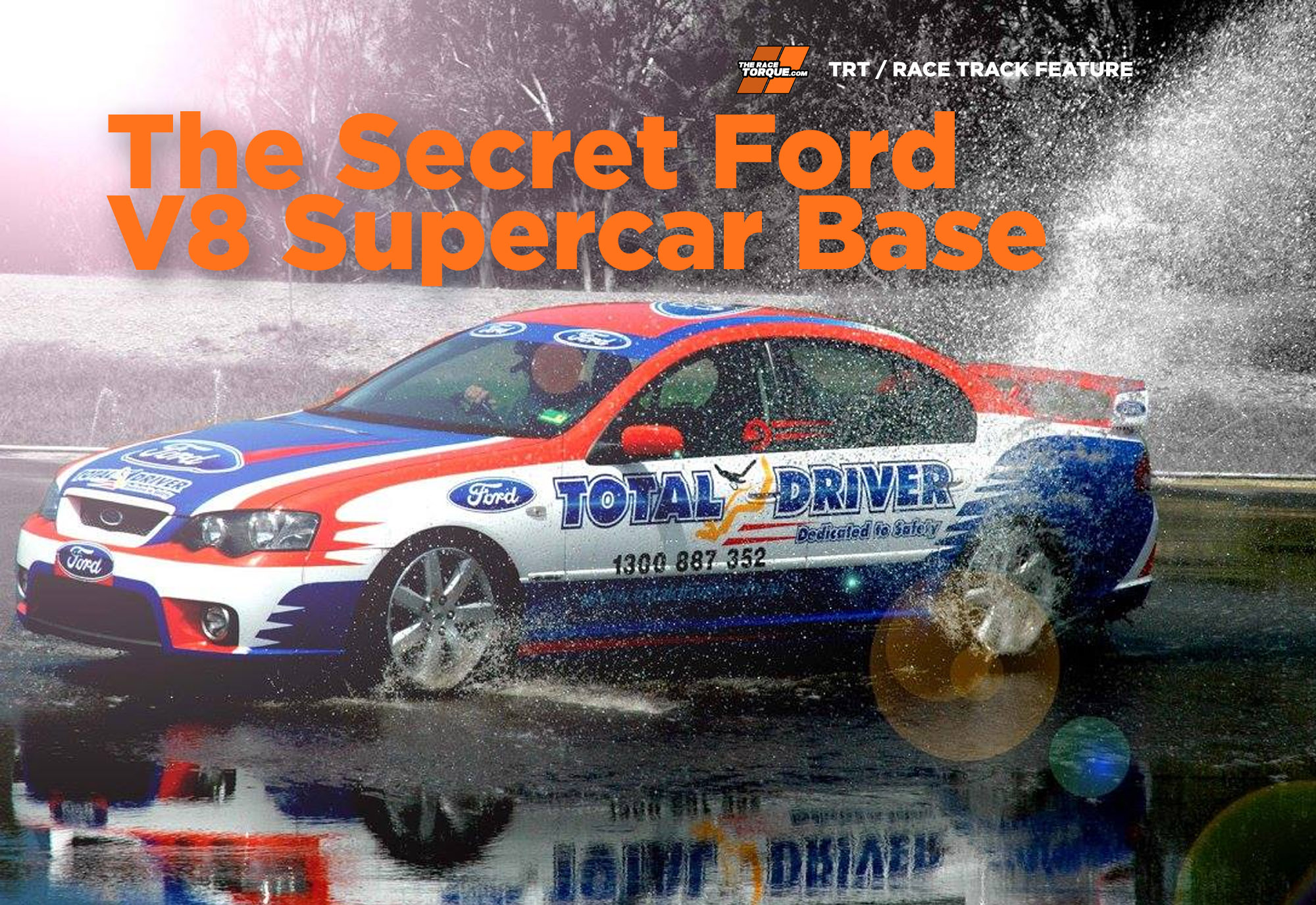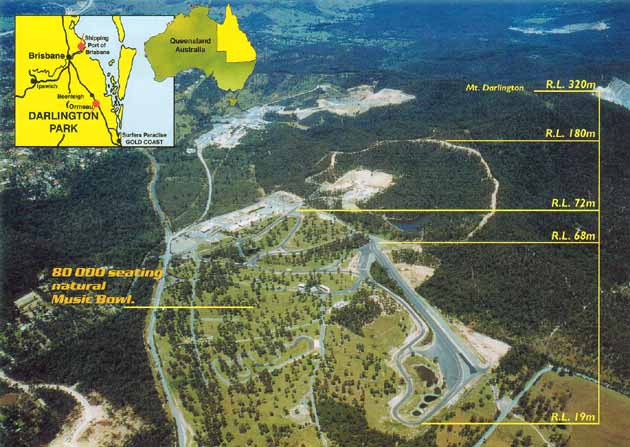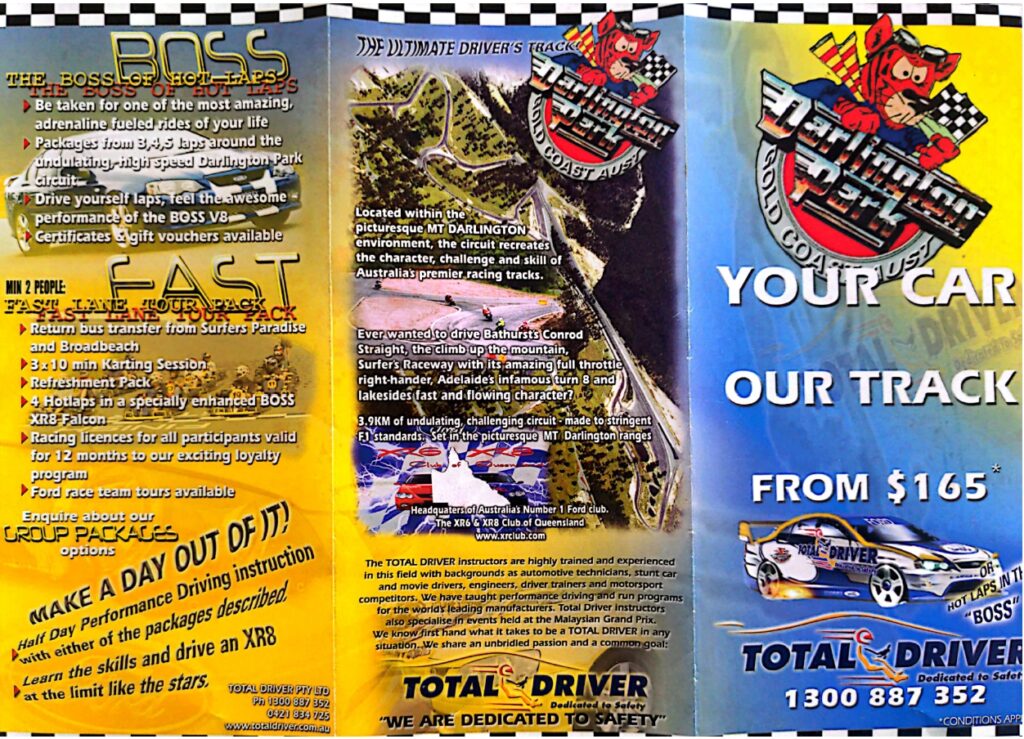Darlington Park: The Secret Ford V8 Supercar Base

“I don’t think I’ve ever seen a place floating around with more stories than Darlington Park!”
Introducing Gene Corbett, whose Total Driver business operated out of Darlington Park up until the venue’s closure, a time when the facility was on the verge of becoming the home of Ford’s V8 Supercars operations.
The Darlington Park backstory: Part 1 – The venue over time. Part 2 – Murder, masterplans and a mountain pass.
“He was typical of those old school guys, he was very much an entrepreneur, he worked harder than a Mallee Bull, he put most 20-year-olds to shame, and if you were a straight shooter, he dealt with you very fairly.”
Gene Corbett on Tony Stephens

An aerial view of Darlington Park, with the on-site quarry just above the RL 72m mark in the middle of the image.
In the Beginning…
While not necessarily everyone saw eye to eye with Darlington Park’s founder Tony Stephens, Corbett approached him with a five-year plan for his business using the race track, with the pair subsequently getting along quite well.
In Darlington Park, Corbett was able to utilise the various functions of the facility, from 4WD tracks to the race track proper.
But to unravel the reasoning behind Darlington Park’s existence in the first place, it’s worth looking at the site from above.
To this date, a massive quarry dominates the landscape of the Yatala block, with the Crushing Dynamics plant eating into the side of Mount Darlington.
Holcim, Hanson, Boral and Fulton Hogan have similar facilities in the area, but it wasn’t always that way.
“(Stephens) original plan was that he just wanted to mine blue metal, that was when they were going to build the M1 and similar projects, but they wouldn’t give him the approval for it,” said Corbett.
“So he went to a different department and told them that they needed a new racetrack – Surfers Paradise International had to be replaced, and Lakeside was getting too old, and he pitched the idea of Darlington Park.
“They all went for it, without realising that he had to mine the blue metal to make his race track.
“That’s why it took so damn long; he had no great desire to finish the track.
“Then, as it progressed forward, he was using the quarry to protect the race track and the race track’s licences to protect the mine.
“So he was the only track operator in the country who didn’t have to use the track to make money, the fact that it was there, it was doing its job, and that’s why that they ran it the way that they ran it.”
During the construction of the facility, Stephens utilised his own special machinery for the concrete pours around the venue.
“He had this tipper style concrete truck, that would mix and pour concrete using blue metal and recyclable materials such as shredded tyres,” said Corbett.
“All of the test pours had better than one per cent accuracy, and the material was not actually mixed until being poured.
“This meant that time, transport and even storage were no longer issues when it came to concrete and batching plants.”
A Total Driver promo video, with the company’s Falcons strutting their stuff at Darlington Park.
The Home of Ford
After working with Frank Gardner, Corbett partnered with automotive brands, including a stint with Mercedes F1, a place where the thinking behind Total Driver was born.
Eventually setting up shop at Darlington Park, Corbett had a base with all of the facilities he could need, covering all ends of the motoring spectrum – although it wasn’t cheap, at $3,000 a day, the rental fee was twice that of nearby Queensland Raceway.
Corbett arrived at a structure where Total Driver made pre-licence driver training work as a marketing funnel for car manufacturers, however, the sticking point was how to develop a plan to protect partners in a chain of liability suit.
Accidents happen, and car companies don’t enjoy getting sued.
In an industry with no real structures, systems or processes in place, once this challenge was overcome, the Darlington Park opportunity allowed Total Driver to build its brand entity and show its program in action.
Enter Ford.
“The Ford deal was going to be quite the deal. It was very, very close… and by and the large, the only thing that shot the thing in the foot was old Tony having heart failure in his sleep and passing away,” said Corbett.
“They would have made it the home of the Ford V8 Supercar teams, with all of the teams out there, all of the supporting industries and agencies there Gasoline Alley style.
“They were going to commit 150 dealers nationally to participate in the driving school program, and that would showcase Darlington Park as its corporate facility of engagement, and then the motor racing side would add the sizzle to the sausage, there was an entire business plan for it.
“Another key point that made Ford keen was that Holden had taken over the Driving Centre with the Morris’s, so it would have been red on one side of the highway, and blue on the other.
“Ford offered $2.4million a year just for naming rights. Tony didn’t want to sell the place, he just wanted to use the track to protect his quarry, because all of the money was in the quarry.
“I had a pretty good relationship with Ford at that stage, and I briefed them on that, saying that the mistake that everyone made is that they tried to buy it – don’t buy it, just do a lease on the place, you pay him to build everything you need, he will build it at a reasonable cost because he has the means, you’ve got what you want, he gets what he wants, and everyone is happy.
“I didn’t see contracts actually put down, but I was in the meetings where we were talking about the plan, how it was going to work, the numbers required, whose commitment was what.
“A sticking point at one stage was that Tony wanted to put dealerships on the main straight, so you could call into a trackside dealership and take a car for a lap around the track, and we all looked at him – “where the hell did that come from?!”
“The only thing as a business I didn’t have as a contingency plan was old Tony dying, it was the last thing I thought would ever happen.”
Following Stephen’s passing, a complicated series of events saw the facility unravel quickly, and swiftly earn its development approval for its current industrial estate form.
Making it Work
With the various constraints imposed by the venue, making the figures stack up for operators wasn’t always easy.
However, Total Driver could utilise all of the different aspects, either for public programs or for car company events.

One such example was a Range Rover Sport launch (left), which featured a 4WD tour through the Darlington Range, around the Bathurst loop and through the quarry, with various other experiences taking place around the race circuit.
“The way I did it is that I ran four events at once, so I co-ordinated and structured the entire event, built it around the theme of our own sprint race series, and then balance that up with the mock-up Supercars experience… basically we always had compatible cars on the track at the same time,” said Corbett.
“It took a lot of organising, but that’s how we made the business profitable.”
Total Driver continues to these days offering a range of programs, including for learners, defensive and advanced drivers, NDIS programs, for 4WD owners and for corporates.
The company also made a play at the control of Lakeside Raceway when the venue’s management was up for tender.
However, through Darlington Park, Corbett positioned the business as a premium offering that delivered statistically significant outcomes for participants.
“All of the bad driving habits out there are so easily fixed if you put the discipline and structure in place right from the very beginning, and you bring everybody on a journey, and for that, you need a program approach, not a lesson approach,” said Corbett.
“To sell that, you need to elevate yourself above the industry, so you want to pay for the right calibre of people.
“We never set out to build a race track, or a be a race track wannabe school or anything like that, there was always a much bigger picture, and you know what, even the Ford guys were trying to sell it to the Council and the State Government, but nobody was interested.”
The Noise Issues…
As we documented in the opening leg of our series, noise was a significant issue for the venue throughout its life, with the battle bouncing around in the courts towards its closing days.
However, as it transpires, the basis for the noise issue was somewhat out of the facility’s control.
“The noise meter that they were being fined on, 80 per cent of the noise violations happened on days when there was nothing happening on track,” said Corbett.
“Max Winders was their noise consultant, and what he worked out in the end was that council had a noise meter on the other side of Stanmore Road, so every time a truck from the Boral Quarry bounced past, they would spike the noise meter, every time a crow would sit on top of the noise meter and squawk, it would spike the noise meter.
“I know when we were operating, we were running mufflers on our cars, they had noise meters with a big screen so you could see the decibel reading as you were coming past, and we were always under it.”
Armed with this evidence, Darlington Park would have had a fighting chance to quash the issues once and for all.
However, much like the circuit’s origins, playing the politics of it all was key.
“He was quite the character, but I’ll give him one thing, he knew how to play the game, like all of those old school boys did.”









